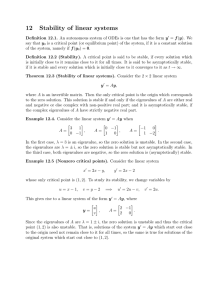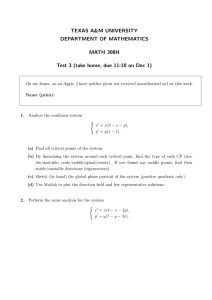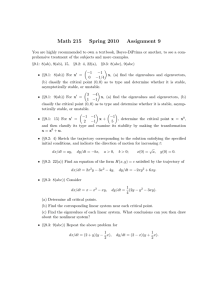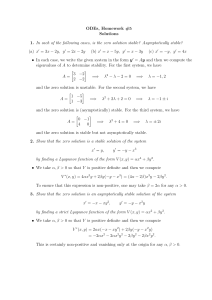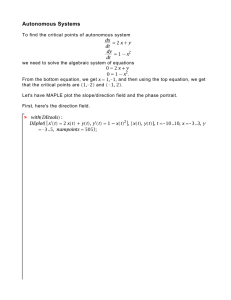The Phase Plane Phase Portraits of Linear Systems
advertisement
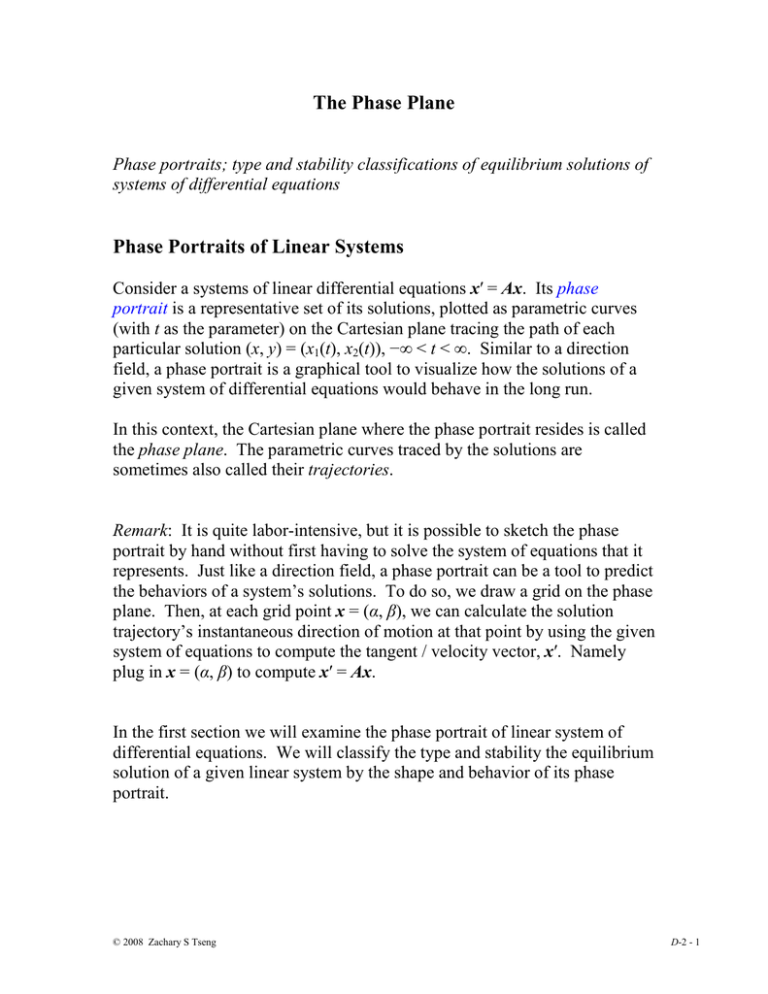
The Phase Plane Phase portraits; type and stability classifications of equilibrium solutions of systems of differential equations Phase Portraits of Linear Systems Consider a systems of linear differential equations x′ = Ax. Its phase portrait is a representative set of its solutions, plotted as parametric curves (with t as the parameter) on the Cartesian plane tracing the path of each particular solution (x, y) = (x1(t), x2(t)), −∞ < t < ∞. Similar to a direction field, a phase portrait is a graphical tool to visualize how the solutions of a given system of differential equations would behave in the long run. In this context, the Cartesian plane where the phase portrait resides is called the phase plane. The parametric curves traced by the solutions are sometimes also called their trajectories. Remark: It is quite labor-intensive, but it is possible to sketch the phase portrait by hand without first having to solve the system of equations that it represents. Just like a direction field, a phase portrait can be a tool to predict the behaviors of a system’s solutions. To do so, we draw a grid on the phase plane. Then, at each grid point x = (α, β), we can calculate the solution trajectory’s instantaneous direction of motion at that point by using the given system of equations to compute the tangent / velocity vector, x′. Namely plug in x = (α, β) to compute x′ = Ax. In the first section we will examine the phase portrait of linear system of differential equations. We will classify the type and stability the equilibrium solution of a given linear system by the shape and behavior of its phase portrait. © 2008 Zachary S Tseng D-2 - 1 Equilibrium Solution (a.k.a. Critical Point, or Stationary Point) An equilibrium solution of the system x′ = Ax is a point (x1, x2) where x′ = 0, that is, where x1′ = 0 = x2′. An equilibrium solution is a constant solution of the system, and is usually called a critical point. For a linear system x′ = Ax, an equilibrium solution occurs at each solution of the system (of homogeneous algebraic equations) Ax = 0. As we have seen, such a system has exactly one solution, located at the origin, if det(A) ≠ 0. If det(A) = 0, then there are infinitely many solutions. For our purpose, and unless otherwise noted, we will only consider systems of linear differential equations whose coefficient matrix A has nonzero determinant. That is, we will only consider systems where the origin is the only critical point. Note: A matrix could only have zero as one of its eigenvalues if and only if its determinant is also zero. Therefore, since we limit ourselves to consider only those systems where det(A) ≠ 0, we will not encounter in this section any matrix with zero as an eigenvalue. © 2008 Zachary S Tseng D-2 - 2 Classification of Critical Points Similar to the earlier discussion on the equilibrium solutions of a single first order differential equation using the direction field, we will presently classify the critical points of various systems of first order linear differential equations by their stability. In addition, due to the truly two-dimensional nature of the parametric curves, we will also classify the type of those critical points by their shapes (or, rather, by the shape formed by the trajectories about each critical point). Comment: The accurate tracing of the parametric curves of the solutions is not an easy task without electronic aids. However, we can obtain very reasonable approximation of a trajectory by using the very same idea behind the direction field, namely the tangent line approximation. At each point x = (x1, x2) on the ty-plane, the direction of motion of the solution curve the passes through the point is determined by the direction vector (i.e. the tangent vector) x′, the derivative of the solution vector x, evaluated at the given point. The tangent vector at each given point can be calculated directly from the given matrix-vector equation x′ = Ax, using the position vector x = (x1, x2). Like working with a direction field, there is no need to find the solution first before performing this approximation. © 2008 Zachary S Tseng D-2 - 3 Given x′ = Ax, where there is only one critical point, at (0,0): Case I. Distinct real eigenvalues The general solution is x = C1 k1 e r1 t + C2 k2 e r2 t . 1. When r1 and r2 are both positive, or are both negative The phase portrait shows trajectories either moving away from the critical point to infinite-distant away (when r > 0), or moving directly toward, and converge to the critical point (when r < 0). The trajectories that are the eigenvectors move in straight lines. The rest of the trajectories move, initially when near the critical point, roughly in the same direction as the eigenvector of the eigenvalue with the smaller absolute value. Then, farther away, they would bend toward the direction of the eigenvector of the eigenvalue with the larger absolute value The trajectories either move away from the critical point to infinite-distant away (when r are both positive), or move toward from infinite-distant out and eventually converge to the critical point (when r are both negative). This type of critical point is called a node. It is asymptotically stable if r are both negative, unstable if r are both positive. © 2008 Zachary S Tseng D-2 - 4 Two distinct real eigenvalues, both of the same sign Type: Node Stability: It is unstable if both eigenvalues are positive; asymptotically stable if they are both negative. © 2008 Zachary S Tseng D-2 - 5 2. When r1 and r2 have opposite signs (say r1 > 0 and r2 < 0) In this type of phase portrait, the trajectories given by the eigenvectors of the negative eigenvalue initially start at infinite-distant away, move toward and eventually converge at the critical point. The trajectories that represent the eigenvectors of the positive eigenvalue move in exactly the opposite way: start at the critical point then diverge to infinite-distant out. Every other trajectory starts at infinite-distant away, moves toward but never converges to the critical point, before changing direction and moves back to infinite-distant away. All the while it would roughly follow the 2 sets of eigenvectors. This type of critical point is called a saddle point. It is always unstable. © 2008 Zachary S Tseng D-2 - 6 Two distinct real eigenvalues, opposite signs Type: Saddle Point Stability: It is always unstable. © 2008 Zachary S Tseng D-2 - 7 Case II. Repeated real eigenvalue 3. When there are two linearly independent eigenvectors k1 and k2. rt rt rt The general solution is x = C1 k1 e + C2 k2 e = e (C1 k1 + C2 k2 ). Every nonzero solution traces a straight-line trajectory, in the direction given by the vector C1 k1 + C2 k2. The phase portrait thus has a distinct star-burst shape. The trajectories either move directly away from the critical point to infinite-distant away (when r > 0), or move directly toward, and converge to the critical point (when r < 0). This type of critical point is called a proper node (or a starl point). It is asymptotically stable if r < 0, unstable if r > 0. Note: For 2 × 2 systems of linear differential equations, this will occur if, and only if, when the coefficient matrix A is a constant multiple of the identity matrix: 1 0 α 0 = 0 α , 0 1 A= α * 1 0 α = any nonzero constant*. 0 1 C In the case of α = 0, the solution is x = C1 + C 2 = 1 . Every solution is an equilibrium C 2 solution. Therefore, every trajectory on its phase portrait consists of a single point, and every point on the phase plane is a trajectory. © 2008 Zachary S Tseng D-2 - 8 A repeated real eigenvalue, two linearly independent eigenvectors Type: Proper Node (or Star Point) Stability: It is unstable if the eigenvalue is positive; asymptotically stable if the eigenvalue is negative. © 2008 Zachary S Tseng D-2 - 9 4. When there is only one linearly independent eigenvector k. rt rt rt Then the general solution is x = C1 k e + C2 (k t e + η e ). The phase portrait shares characteristics with that of a node. With only one eigenvector, it is a degenerated-looking node that is a cross between a node and a spiral point (see case 6 below). The trajectories either all diverge away from the critical point to infinite-distant away (when r > 0), or all converge to the critical point (when r < 0). This type of critical point is called an improper node. It is asymptotically stable if r < 0, unstable if r > 0. © 2008 Zachary S Tseng D-2 - 10 A repeated real eigenvalue, one linearly independent eigenvector Type: Improper Node Stability: It is unstable if the eigenvalue is positive; asymptotically stable if the eigenvalue is negative. © 2008 Zachary S Tseng D-2 - 11 Case III. Complex conjugate eigenvalues The general solution is x = C1 e λ t (a cos( µ t ) − b sin( µ t ) ) + C2 e λ t (a sin( µ t ) + b cos( µ t ) ) 5. When the real part λ is zero. In this case the trajectories neither converge to the critical point nor move to infinite-distant away. Rather, they stay in constant, elliptical (or, rarely, circular) orbits. This type of critical point is called a center. It has a unique stability classification shared by no other: stable (or neutrally stable). It is NOT asymptotically stable and one should not confuse them. 6. When the real part λ is nonzero. The trajectories still retain the elliptical traces as in the previous case. However, with each revolution, their distances from the critical point grow/decay exponentially according to the term eλt. Therefore, the phase portrait shows trajectories that spiral away from the critical point to infinite-distant away (when λ > 0). Or trajectories that spiral toward, and converge to the critical point (when λ < 0). This type of critical point is called a spiral point. It is asymptotically stable if λ < 0, it is unstable if λ > 0. © 2008 Zachary S Tseng D-2 - 12 Complex eigenvalues, with real part zero (purely imaginary numbers) Type: Center Stability: Stable (but not asymptotically stable); sometimes it is referred to as neutrally stable. © 2008 Zachary S Tseng D-2 - 13 Complex eigenvalues, with nonzero real part Type: Spiral Point Stability: It is unstable if the eigenvalues have positive real part; asymptotically stable if the eigenvalues have negative real part. © 2008 Zachary S Tseng D-2 - 14 Summary of Stability Classification Asymptotically stable – All trajectories of its solutions converge to the critical point as t → ∞. A critical point is asymptotically stable if all of A’s eigenvalues are negative, or have negative real part for complex eigenvalues. Unstable – All trajectories (or all but a few, in the case of a saddle point) start out at the critical point at t → − ∞, then move away to infinitely distant out as t → ∞. A critical point is unstable if at least one of A’s eigenvalues is positive, or has positive real part for complex eigenvalues. Stable (or neutrally stable) – Each trajectory move about the critical point within a finite range of distance. It never moves out to infinitely distant, nor (unlike in the case of asymptotically stable) does it ever go to the critical point. A critical point is stable if A’s eigenvalues are purely imaginary. In short, as t increases, if all (or almost all) trajectories 1. converge to the critical point → asymptotically stable, 2. move away from the critical point to infinitely far away → unstable, 3. stay in a fixed orbit within a finite (i.e., bounded) range of distance away from the critical point → stable (or neutrally stable). © 2008 Zachary S Tseng D-2 - 15 Nonhomogeneous Linear Systems with Constant Coefficients Now let us consider the nonhomogeneous system x′ = Ax + b. Where b is a constant vector. The system above is explicitly: x1 ′ = a x1 + b x2 + g 1 x2 ′ = c x1 + d x2 + g 2 As before, we can find the critical point by setting x1′ = x2′ = 0 and solve the resulting nonhomgeneous system of algebraic equations. The origin will no longer be a critical point, since the zero vector is never a solution of a nonhomogeneous linear system. Instead, the unique critical point (as long as A has nonzero determinant, there remains exactly one critical point) will be located at the solution of the system of algebraic equations: 0 = a x1 + b x2 + g 1 0 = c x1 + d x2 + g 2 Once we have found the critical point, say it is the point (x1, x2) = (α, β), it then could be moved to (0, 0) via the translations χ1 = x1 − α and χ2 = x2 − β. The result after the translation would be the homogeneous linear system χ ′ = Aχ. The two systems (before and after the translations) have the same coefficient matrix.* Their respective critical points will also have identical type and stability classification. Therefore, to determine the type and stability of the critical point of the given nonhomogeneous system, all we need to do is to disregard b, then take its coefficient matrix A and use its eigenvalues for the determination, in exactly the same way as we would do with the corresponding homogeneous system of equations. © 2008 Zachary S Tseng D-2 - 16 * (Optional topic) Note: Here is the formal justification of our ability to discard the vector b when determining the type and stability of the critical point of the nonhomogenous system x′ = Ax + b. Suppose (x1, x2) = (α, β) is the critical point of the system. That is 0 = a α + b β + g1 0 = c α + d β + g2 Now apply the translations χ1 = x1 − α and χ2 = x2 − β. We see that x1 = χ1 + α, x2 = χ2 + β, χ1′ = x1′, and χ2′ = x2′. Substitute them into the system x′ = Ax + b: x1′ = χ1′ = a x1 + b x2 + g1 = a(χ1 + α) + b(χ2 + β) + g1 = a χ1 + b χ2 + (a α + b β + g1) = a χ1 + b χ2 x2′ = χ2′ = c x1 + d x2 + g2 = c(χ1 + α) + d(χ2 + β) + g2 = c χ1 + d χ2 + (c α + d β + g2) = c χ1 + d χ2 That is, with the new variables χ1 and χ2 the given system has become χ1 ′ = a χ1 + b χ2 χ2 ′ = c χ1 + d χ2 Notice it has the form χ ′ = Aχ. That is, it is a homogeneous system (with the critical point at the origin) whose coefficient matrix is exactly A, the same as the original system’s. Hence, b could be disregarded, and a determination of the type and stability of the critical point of the system (with or without the translations) could be based solely on the coefficient matrix A. © 2008 Zachary S Tseng D-2 - 17 Example: x1 ′ = x1 − 2 x2 − 1 x2′ = 2 x1 − 3x2 − 3 The critical point is at (3, 1). The matrix A has characteristic equation r2 + 2r + 1 = 0. It has a repeated eigenvalue r = − 1 that has only one linearly independent eigenvector. Therefore, the critical point at (3, 1) is an asymptotically stable improper node. The phase portrait is shown below. © 2008 Zachary S Tseng D-2 - 18 Example: x1′ = −2 x1 − 6 x2 + 8 x2′ = 8 x1 + 4x2 − 12 The critical point is at (1, 1). The matrix A has characteristic equation r2 − 2r + 40 = 0. It has complex conjugate eigenvalues with positive real part, λ = 1. Therefore, the critical point at (1, 1) is an unstable spiral point. The phase portrait is shown below. © 2008 Zachary S Tseng D-2 - 19 Exercises D-2.1: 1 – 8 Determine the type and stability or the critical point at (0,0) of each system below. 2 7 x. −5 −10 1. x′ = − 3 6 x. − 3 3 2. x′ = 3. 8 − 4 x′ = x. 1 4 4. 6 x′ = 2 5. x′ = −1 −1 x. 1 −1 6. x′ = 7. 1 4 x′ = x. 2 3 8. 6 − 5 x′ = x. 0 6 8 x. 6 −4 0 x. 0 −4 9. (i) For what value(s) of b will the system below have an improper node at (0,0)? (ii) For what value(s) of b will the system below have a spiral point at (0,0)? 5 b x′ = x. 2 −1 10 – 14 Find the critical point of each nonhomogeneous linear system given. Then determine the type and stability of the critical point. 10. 1 2 x′ = x + 6 − 3 − 6 24 . 12. 0 6 x′ = x+ − 7 0 3 7 . 14. 5 − 6 − 13 x′ = x + 0 . 3 − 1 © 2008 Zachary S Tseng 11. 3 0 x′ = x+ 0 3 12 − 3 . 13. − 3 − 2 x′ = x + 2 1 4 −2 . D-2 - 20 Answers D-2.1: 1. Node, asymptotically stable 2. Center, stable 3. Improper node, unstable 4. Node, unstable 5. Spiral point, asymptotically stable 6. Proper node (or start point), asymptotically stable 7. Saddle point, unstable 8. Improper node, unstable 9. (i) b = 9/2, (ii) b < −9/2 10. (−2, 4) is a saddle point, unstable. 11. (−4, 1) is a proper node (star point), unstable. 12. (1, −0.5) is a center, stable. 13. (0, 2) is an improper node, asymptotically stable 14. (−1, −3) is a spiral point, unstable. © 2008 Zachary S Tseng D-2 - 21 Nonlinear Systems Consider a nonlinear system of differential equations: x′ = F(x,y) y′ = G(x,y) Where F and G are functions of two variables: x = x(t) and y = y(t); and such that F and G are not both linear functions of x and y. Unlike a linear system, a nonlinear system could have none, one, two, three, or any number of critical points. Like a linear system, however, the critical points are found by setting x′ = y′ = 0, and solve the resulting system 0 = F(x,y) 0 = G(x,y) Any and every solution of this system of algebraic equations is a critical point of the given system of differential equations. Since there might be multiple critical points present on the phase portrait, each trajectory could be influenced by more than one critical point. This results in a much more chaotic appearance of the phase portrait. Consequently, the type and stability of each critical point need to be determined locally (in a small neighborhood on the phase plane around the critical point in question) on a case-by-case basis. Without detailed calculation, we could estimate (meaning, the result is not necessarily 100% accurate) the type and stability by a little bit of multi-variable calculus. We will approximate the behavior of the nearby trajectories using the linearizations (i.e. the tangent approximations) of F and G about each critical point. This converts the nonlinear system into a linear system whose phase portrait approximates the local behavior of the original nonlinear system near the critical point. To wit, start with the lineariztions of F and G (recall that such a linearization is just the 3 lowest order terms in the Taylor series expansion of each function) about the critical point (x, y) = (α, β). © 2008 Zachary S Tseng D-2 - 22 x′ = F(x,y) ≈ F(α, β) + Fx(α, β)(x − α) + Fy(α, β)(y − β) y′ = G(x,y) ≈ G(α, β) + Gx(α, β)(x − α) + Gy(α, β)(y − β) But since (α, β) is a critical point, so F(α, β) = 0 = G(α, β), the above linearizations become x′ ≈ Fx(α, β)(x − α) + Fy(α, β)(y − β) y′ ≈ Gx(α, β)(x − α) + Gy(α, β)(y − β) As before, the critical point could be translated to (0, 0) and still retains its type and stability, using the substitutions χ = x − α and γ = y − β. After the translation, the approximated system becomes x′ = Fx(α, β) x + Fy(α, β) y y′ = Gx(α, β) x + Gy(α, β) y It is now a homogeneous linear system with a coefficient matrix Fx (α , β ) Fy (α , β ) A = G (α , β ) G (α , β ) . y x That is, it is a matrix calculate by plugging in x = α and y = β into the matrix of first partial derivatives Fx J = G x Fy G y . This matrix of first partial derivatives, J, is often called the Jacobian matrix. It just needs to be calculated once for each nonlinear system. For each critical point of the system, all we need to do is to compute the coefficient matrix of the linearized system about the given critical point (x, y) = (α, β), and then use its eigenvalues to determine the (approximated) type and stability. © 2008 Zachary S Tseng D-2 - 23 Example: x′ = x − y y′ = x2 + y2 − 2 The critical points are at (1, 1) and (−1, −1). The Jacobian matrix is 1 − 1 J = 2 x 2 y . At (1, 1), the linearized system has coefficient matrix: 1 − 1 A = 2 2 . The eigenvalues are r = 3 ± 7i . The critical point is an unstable 2 spiral point. At (−1, −1), the linearized system has coefficient matrix: 1 − 1 A = − 2 − 2 . The eigenvalues are r = − 1± 17 . The critical point is an unstable 2 saddle point. The phase portrait is shown on the next page. © 2008 Zachary S Tseng D-2 - 24 (1, 1) is an unstable spiral point. (−1, −1) is an unstable saddle point. © 2008 Zachary S Tseng D-2 - 25 Example: x′ = x − xy y′ = y + 2 xy The critical points are at (0, 0) and (−1/2, 1). The Jacobian matrix is −x 1 − y J = 2 y 1 + 2 x At (0, 0), the linearized system has coefficient matrix: 1 0 A = 0 1 . There is a repeated eigenvalue r = 1. A linear system would normally have an unstable proper node (star point) here. But as a nonlinear system it actually has an unstable node. (Didn’t I say that this approximation using linearization is not always 100% accurate?) At (−1/2, 1), the linearized system has coefficient matrix: 0 1 / 2 A = 2 0 . The eigenvalues are r = 1 and −1. Thus, the critical point is an unstable saddle point. The phase portrait is shown on the next page. © 2008 Zachary S Tseng D-2 - 26 (0, 0) is an unstable node. (−1/2, 1) is an unstable saddle point. © 2008 Zachary S Tseng D-2 - 27 Exercises D-2.2: Find all the critical point(s) of each nonlinear system given. Then determine the type and stability of each critical point. 1. x′ = xy + 3y y′ = xy − 3x 2. x′ = x2 − 3xy + 2x y′ = x + y − 1 3. x′ = x2 + y2 − 13 y′ = xy − 2x − 2y + 4 4. x′ = 2 − x2 − y2 y′ = x2 − y2 5. x′ = x2y + 3xy – 10y y′ = xy − 4x Answer D-2.2: 1. Critical points are (0, 0) and (−3, 3). (0, 0) is a stable center, and (−3, 3) is an unstable saddle point. 2. Critical points are (0, 1) and (1/4, 3/4). (0, 1) is an unstable saddle point, and (1/4, 3/4) is an unstable spiral point. 3. Critical points are (2, 3), (2, −3), (3, 2), and (−3, 2). (2, 3) is an unstable saddle point, (2, −3) is an unstable saddle point, (3, 2) is an unstable node, and (−3, 2) is an asymptotically stable node. 4. Critical points are (1, 1), (1, −1), (−1, 1), and (−1, −1). (1, 1) is an asymptotically stable spiral point, (1, −1) and (−1, 1) both are unstable saddle points, and (−1, −1) is an unstable spiral point. 5. Critical points are (0, 0), (2, 4), and (−5, 4). (0, 0) is an unstable saddle point, (2, 4) is an unstable node, and (−5, 4) is an asymptotically stable node. © 2008 Zachary S Tseng D-2 - 28


